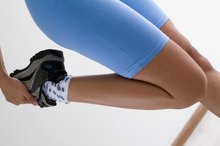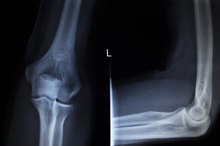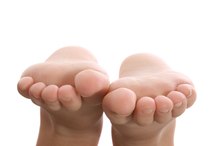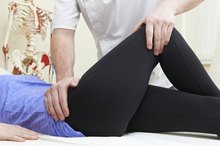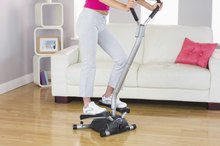Iliopsoas Tendon Pain When Walking
Iliopsoas tendon issues can hinder your ability to walk, as the iliopsoas muscle plays a role in the movement of your hip and thigh. The iliopsoas muscle is actually two muscles -- the iliacus and the psoas -- that stretch from your spine into your hip and upper thigh area. Iliopsoas tendonitis often goes undiagnosed; it is characterized by pain when you walk up or downhill and when you flex your knee into your chest.
The Iliopsoas Tendon
While the ilopsoas muscle encompasses a large area in your hip, the tendon itself is relatively small, inserting onto your femur or upper thigh bone. Inflammation or a rupture to this tendon can lead to groin pain when you pull your knee into your chest, a tightening or swelling sensation in the groin or symptoms of pain that cease during exercise only to return once exercise stops. You can also experience "snapping hip" syndrome. Occurring most frequently in dancers, runners and hurdlers, this syndrome is associated with an audible snapping sound when you walk. In this case, the noise can come from your iliopsoas tendon moving over part of your hip bone.
- While the ilopsoas muscle encompasses a large area in your hip, the tendon itself is relatively small, inserting onto your femur or upper thigh bone.
- Occurring most frequently in dancers, runners and hurdlers, this syndrome is associated with an audible snapping sound when you walk.
Injury Causes
Stretching Exercises for ACL Injuries
Learn More
Your iliopsoas muscle and tendon work to flex your thigh, bringing it toward your trunk. Overuse is one of the most common causes of injury for the muscle or tendon. Sports that involve repetitive hip flexion, like hurdling, running and dance, have a higher incidence of iliopsoas tendon injuries. Straining or tearing of the muscle is often caused by a sudden contraction of the iliopsoas muscle, resulting in a rupture or tear of the muscle, usually at the point where the muscle and tendon connect.
- Your iliopsoas muscle and tendon work to flex your thigh, bringing it toward your trunk.
- Sports that involve repetitive hip flexion, like hurdling, running and dance, have a higher incidence of iliopsoas tendon injuries.
Treatment
Iliopsoas tendon treatment includes rest. Resting for two to three weeks from aggravating exercise is recommended. Scaling down your workout's intensity and distance is important; this injury, similar to Achilles tendonitis, can take months to fully heal. Treatment also typically includes stretching and strengthening exercises that gradually increase your range of motion.
- Iliopsoas tendon treatment includes rest.
- Treatment also typically includes stretching and strengthening exercises that gradually increase your range of motion.
Stretching Exercises
What Are the Symptoms of Torn Tendons?
Learn More
Performing stretches for your quadriceps -- or front thigh -- muscles will also help to stretch your iliopsoas. You can stand on your uninjured leg, pulling the injured leg's heel toward your buttock. Reach back and grasp your foot, gently pulling your heel into your body for an additional stretch. You can also lie on your bed, placing your hips over the edge of the bed. Let your injured leg hang down toward the floor until you feel a stretch in your front thigh and hip area.
- Performing stretches for your quadriceps -- or front thigh -- muscles will also help to stretch your iliopsoas.
- You can stand on your uninjured leg, pulling the injured leg's heel toward your buttock.
Strengthening Exercises
Strong abdominal and core muscles can help support hip flexion. Performing planks, side planks, bridges, heel dig bridges and core exercises with a stability ball may help improve your iliopsoas injury. Strengthening your hip flexors with exercise bands is also recommended. You can perform hip flexion, leg extensions, and leg movements toward and away from the body to improve your range of motion while targeting your iliopsoas and surrounding muscles.
- Strong abdominal and core muscles can help support hip flexion.
- Performing planks, side planks, bridges, heel dig bridges and core exercises with a stability ball may help improve your iliopsoas injury.
Related Articles
References
- Dr. Pribut's Running Injuries Page; Iliopsoas Tendonitis: The Great Masquerader; Stephen Pribut, DPM; May 21, 2011
- SportsInjuryClinic.net: Inflammation of the iliopsoas muscle (and bursa)
- Massage Therapy and Healthy Living; Hip Pain; Brad Walker
- Bordoni B, Varacallo M. Anatomy, bony pelvis and lower limb, iliopsoas muscle. StatPearls Publishing; 2019.
- Harvard Health Publishing. The ideal stretching routine. n.d.
Writer Bio
Christy Callahan has been researching and writing in the integrative health care field for over five years, focusing on neuro-endocrinology. She has a Bachelor of Science degree in biology, earned credits toward a licensure in traditional Chinese medicine and is a certified Pilates and sport yoga instructor.
